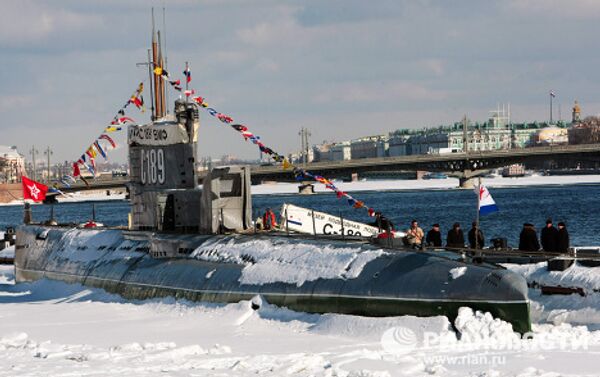https://sputnikglobe.com/20100322/158274719.html
Russia's first interactive Submarine Museum
Russia's first interactive Submarine Museum
Sputnik International
Russia’s first private submarine museum opened in St. Petersburg on March 18, 2010, in the run-up to Submariner Day. 22.03.2010, Sputnik International
2010-03-22T13:40+0000
2010-03-22T13:40+0000
2010-03-22T13:40+0000
https://cdn1.img.sputnikglobe.com/img/15827/45/158274564_0:0:0:0_1920x0_80_0_0_1b7392473495329f94bb5da81b21abfc.jpg
Sputnik International
feedback@sputniknews.com
+74956456601
MIA „Rossiya Segodnya“
2010
Sputnik International
feedback@sputniknews.com
+74956456601
MIA „Rossiya Segodnya“
News
en_EN
Sputnik International
feedback@sputniknews.com
+74956456601
MIA „Rossiya Segodnya“
Sputnik International
feedback@sputniknews.com
+74956456601
MIA „Rossiya Segodnya“
photo
Russia's first interactive Submarine Museum Russia’s first private submarine museum opened in St. Petersburg on March 18, 2010, in the run-up to Submariner Day.
Russia’s first private submarine museum opened in St. Petersburg on March 18, 2010, in the run-up to Submariner Day.
© RIA Novosti . Alexei Danichev / Go to the mediabank Russia’s first private submarine museum opened in St. Petersburg on March 18, 2010, in the run-up to Submariner Day. Russia’s first private submarine museum opened in St. Petersburg on March 18, 2010, in the run-up to Submariner Day.
© RIA Novosti . Alexei Danichev / Go to the mediabank This is the only surviving submarine of the 215 units that were built within Project 613, the most numerous class in the Soviet submarine fleet. This is the only surviving submarine of the 215 units that were built within Project 613, the most numerous class in the Soviet submarine fleet.
© RIA Novosti . Alexei Danichev / Go to the mediabank The diesel electric submarine, hull number S-189, was laid up at St. Petersburg’s Lt. Schimdt embankment and was built at the Baltic plant to be stationed at the Kronstadt submarine base in 1955. The diesel electric submarine, hull number S-189, was laid up at St. Petersburg’s Lt. Schimdt embankment and was built at the Baltic plant to be stationed at the Kronstadt submarine base in 1955.
© RIA Novosti . Alexei Danichev / Go to the mediabank Thousands of sailors, petty officers and officers learned to pilot submarines on this vessel before 1988. Thousands of sailors, petty officers and officers learned to pilot submarines on this vessel before 1988.
© RIA Novosti . Alexei Danichev / Go to the mediabank In 1990, the submarine was decommissioned and later sank at the Kronstadt port. In 1990, the submarine was decommissioned and later sank at the Kronstadt port.
© RIA Novosti . Alexei Danichev / Go to the mediabank The Leningrad submarine base could not afford to raise the submarine. It spent six years on the seabed before veteran submariners decided they could make a museum out of it. With former mariner Andrei Artyushin’s charitable aid, the submarine was raised from the bottom and laid up at the Kanonersky Ship Repair Yard in late 2005. The Leningrad submarine base could not afford to raise the submarine. It spent six years on the seabed before veteran submariners decided they could make a museum out of it. With former mariner Andrei Artyushin’s charitable aid, the submarine was raised from the bottom and laid up at the Kanonersky Ship Repair Yard in late 2005.
© RIA Novosti . Alexei Danichev / Go to the mediabank It took over two years to restore the submarine’s interior and equipment. Photo: visitor at Russia’s first private submarine museum. It took over two years to restore the submarine’s interior and equipment. Photo: visitor at Russia’s first private submarine museum.
© RIA Novosti . Alexei Danichev / Go to the mediabank In August, 2007, the submarine was docked at Lt. Schmidt embankment and work on the museum commenced. Photo: visitor at Russia’s first private submarine museum. In August, 2007, the submarine was docked at Lt. Schmidt embankment and work on the museum commenced. Photo: visitor at Russia’s first private submarine museum.
© RIA Novosti . Alexei Danichev / Go to the mediabank Organizers decided to make the submarine museum as interactive as possible. Visitors can try on a rescue suit for example. Organizers decided to make the submarine museum as interactive as possible. Visitors can try on a rescue suit for example.
© RIA Novosti . Alexei Danichev / Go to the mediabank Museum organizers say visitors can “turn and rotate” every control and valve here. Museum organizers say visitors can “turn and rotate” every control and valve here.
© RIA Novosti . Alexei Danichev / Go to the mediabank The museum’s director, Cpt. 1st Class (Ret.) General Nikolai Chernyshyov commanded a submarine a few decades ago. The museum’s director, Cpt. 1st Class (Ret.) General Nikolai Chernyshyov commanded a submarine a few decades ago.














